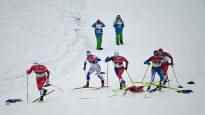Planica World Cup skiing on channels 22.2.–5.3.2023. See the program and broadcast information of the World Ski Championships at this link.
Planica’s World Cup skiing started on Wednesday, when the weaker ski countries qualified for the actual World Cup finals. On Thursday, the organizers ended up salting the race track to a sprint run in traditional skiing.
Sea salt can be used to harden a track that has softened due to too high a temperature.
– When you take the snow in your hand and squeeze it, you have to squeeze the water out of it properly. If this is not the case, the desired chemical reaction in salting will not succeed. Jussi Prykäri tells.
Planica’s World Championships will end on March 5. Before then, there will be plenty of buzz on the tracks, as there is only one break in the races, February 27. Salting is a robust method, because excessive salting can weaken the tracks.
– The most important thing is to take care that the snow does not die. If you add too much salt, the snow will no longer freeze, says Pyrkäri.
The decision on salting is made by the judges’ council, whose goal is to guarantee safe and equal conditions for the athletes. Salting the tracks is a relatively new tool in the toolbox of race organizers.
The first case of Prykär’s TD career falls on the final distance of the Liberec WC, the men’s 50 km (p). In the 2015 World Championships in Falun, the use of salt on the tracks was resorted to on a couple of trips.
Also worked for TD since 2008 Annmari Viljanmaa says that in the competitions he runs, the saltings can be counted on the fingers of one hand. One of these happened at the 2019 World Championships in Seefeld, where the 7.5 km Baana used in the 50 km had to be hardened in sunny spots for safety reasons.
– A bit like sowing seeds in a field in the old fashion, Viljanmaa describes an operation carried out by twenty people.
Lessons learned from the Oberstdorf incident
However, the fact that the tracks end up being salted on the very first day of the World Championships in Planica is not unusual, however.
Two years ago, at the World Championships in Oberstdorf, temperatures hovered at ten degrees Celsius, which is why the tracks were salted every day of the competition.
At that time, Finnish maintenance was able to provide Finnish skiers with the winning ski for the vast majority of competitions, even though the organizers caused the maintenance a headache.
– The organizers didn’t salt the practice tracks, and when you couldn’t go to the race tracks to test outside of the games even once, you just had to keep a cool head and draw conclusions from the races, who served as Finland’s maintenance manager at the World Championships in Oberstdorf Martin Norrgard remembers.
Working in the Finnish maintenance forces Aki Hukka communicates in Planica that the local organizers have learned from the Oberstdorf Games and have also salted the practice tracks for the maintenance crews.
If the Planica organizers have succeeded in salting and the following night it is freezing, new salting may not be necessary before the men’s combined competition on Friday.
– If it doesn’t rain, I believe that Planica’s tracks will stay in better condition than in Oberstdorf.
The start times of the races also suggest that the tracks will last better than two years ago. The men’s combined competition starts on Friday at 15:30 local time, i.e. two hours later than in Oberstdorf.
– The weather starts to cool down just at that time, and especially in the alpine countries and in Planica, the shadow areas increase. The better condition the tracks stay in, the smaller the differences remain, Norrgård states.
